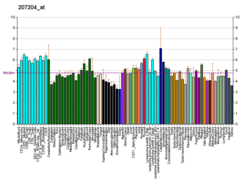FSCN2
Fascin-2 is a protein that in humans is encoded by the FSCN2 gene.[5][6]
This gene encodes a member of the fascin protein family. Fascins crosslink actin into filamentous bundles within dynamic cell extensions. This family member is proposed to play a role in photoreceptor disk morphogenesis. A mutation in this gene results in one form of autosomal dominant retinitis pigmentosa and macular degeneration. Multiple transcript variants encoding different isoforms have been found for this gene.[6]
References
- GRCh38: Ensembl release 89: ENSG00000186765 - Ensembl, May 2017
- GRCm38: Ensembl release 89: ENSMUSG00000025380 - Ensembl, May 2017
- "Human PubMed Reference:". National Center for Biotechnology Information, U.S. National Library of Medicine.
- "Mouse PubMed Reference:". National Center for Biotechnology Information, U.S. National Library of Medicine.
- Bardien-Kruger S, Greenberg J, Tubb B, Bryan J, Queimado L, Lovett M, Ramesar RS (Jun 1999). "Refinement of the RP17 locus for autosomal dominant retinitis pigmentosa, construction of a YAC contig and investigation of the candidate gene retinal fascin". Eur J Hum Genet. 7 (3): 332–8. doi:10.1038/sj.ejhg.5200302. PMID 10234509.
- "Entrez Gene: FSCN2 fascin homolog 2, actin-bundling protein, retinal (Strongylocentrotus purpuratus)".
Further reading
- Hillier LD, Lennon G, Becker M, et al. (1997). "Generation and analysis of 280,000 human expressed sequence tags". Genome Res. 6 (9): 807–28. doi:10.1101/gr.6.9.807. PMID 8889549.
- Tubb BE, Bardien-Kruger S, Kashork CD, et al. (2000). "Characterization of human retinal fascin gene (FSCN2) at 17q25: close physical linkage of fascin and cytoplasmic actin genes". Genomics. 65 (2): 146–56. doi:10.1006/geno.2000.6156. PMID 10783262.
- Saishin Y, Ishikawa R, Ugawa S, et al. (2000). "Retinal fascin: functional nature, subcellular distribution, and chromosomal localization". Invest. Ophthalmol. Vis. Sci. 41 (8): 2087–95. PMID 10892848.
- Wada Y, Abe T, Takeshita T, et al. (2001). "Mutation of human retinal fascin gene (FSCN2) causes autosomal dominant retinitis pigmentosa". Invest. Ophthalmol. Vis. Sci. 42 (10): 2395–400. PMID 11527955.
- Guan Y, Woo PL, Rubenstein NM, Firestone GL (2002). "Transforming growth factor-alpha abrogates the glucocorticoid stimulation of tight junction formation and reverses the steroid-induced down-regulation of fascin in rat mammary epithelial tumor cells by a Ras-dependent pathway". Exp. Cell Res. 273 (1): 1–11. doi:10.1006/excr.2001.5415. PMID 11795941.
- Strausberg RL, Feingold EA, Grouse LH, et al. (2003). "Generation and initial analysis of more than 15,000 full-length human and mouse cDNA sequences". Proc. Natl. Acad. Sci. U.S.A. 99 (26): 16899–903. doi:10.1073/pnas.242603899. PMC 139241. PMID 12477932.
- Wada Y, Abe T, Itabashi T, et al. (2003). "Autosomal dominant macular degeneration associated with 208delG mutation in the FSCN2 gene". Arch. Ophthalmol. 121 (11): 1613–20. doi:10.1001/archopht.121.11.1613. PMID 14609921.
- Gerhard DS, Wagner L, Feingold EA, et al. (2004). "The status, quality, and expansion of the NIH full-length cDNA project: the Mammalian Gene Collection (MGC)". Genome Res. 14 (10B): 2121–7. doi:10.1101/gr.2596504. PMC 528928. PMID 15489334.
- Gamundi MJ, Hernan I, Maseras M, et al. (2006). "Sequence variations in the retinal fascin FSCN2 gene in a Spanish population with autosomal dominant retinitis pigmentosa or macular degeneration". Mol. Vis. 11: 922–8. PMID 16280978.
- Zhang Q, Li S, Xiao X, et al. (2007). "The 208delG mutation in FSCN2 does not associate with retinal degeneration in Chinese individuals". Invest. Ophthalmol. Vis. Sci. 48 (2): 530–3. doi:10.1167/iovs.06-0669. PMID 17251446.
This article is issued from Wikipedia. The text is licensed under Creative Commons - Attribution - Sharealike. Additional terms may apply for the media files.




